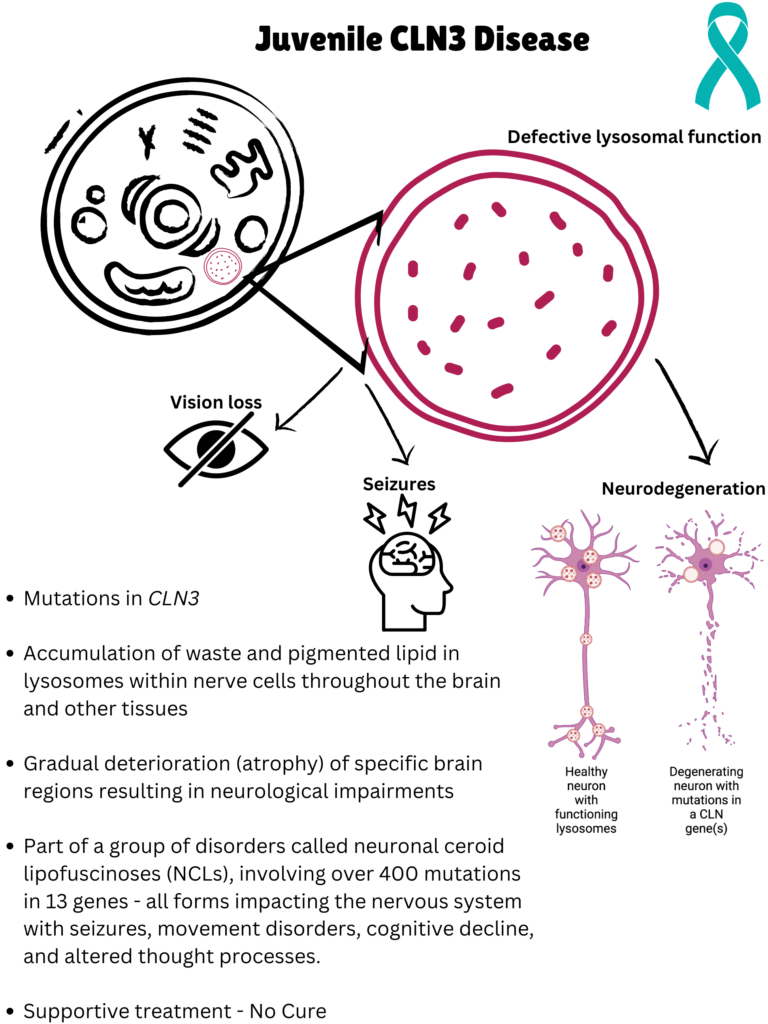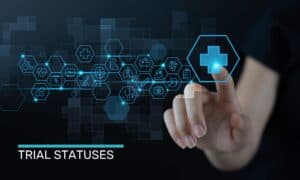Juvenile CLN3 disease, commonly known as Juvenile Batten Disease, is an extremely rare and fatal inherited disorder primarily affecting the nervous system in children. The disease is caused by mutations in the CLN3 gene, which encodes the CLN3 protein. More than sixty-seven different mutations in the CLN3 gene have been identified as responsible for Juvenile Batten Disease. Often classified within the group of neuronal ceroid lipofuscinoses (NCLs), this rare genetic ailment stems from abnormalities in genes responsible for processing waste material called ceroid lipofuscin within cells, particularly impairing lysosomal function resulting in abnormal accumulation of pigmented lipids (ceroid and lipofuscin) within nerve cells throughout the brain and other tissues. This accumulation leads to the gradual deterioration (atrophy) of specific brain regions and results in neurological impairments and distinctive symptoms. Neuronal ceroid lipofuscinoses NCLs are categorized into 13 distinct forms, each identified by a specific subtype (e.g., CLN1, CLN2) determined by the associated genetic variant. June 9 is celebrated as International Batten Disease Awareness Day.

Image: Juvenile CLN3 Disease Overview; Image Source: Malini Gupta
Clinical Description and classification
| Classification Level | Disorder |
| Prevalence | 2-4/100,000 |
| Age of Onset | Infantile – Adult |
| Inheritance | Autosomal recessive |
- Typically, symptoms of juvenile CLN3 disease manifest between the ages of 5 and 15 years. Initial signs may be subtle and include clumsiness, balance issues, and changes in behavior or personality
- Progressive vision loss typically begins in previously healthy children aged 5 to 10 years.
- Subtle to pronounced personality and behavioral changes typically emerge around age 6.
- Seizures usually start around 8 years of age but can occur at any point during the disease progression.
- Intellectual decline becomes evident, resulting in difficulty keeping pace with peers.
- Echolalia, where repetitive speech patterns develop (e.g., echoing phrases without awareness).
- Loss of speech capability.
- Motor impairments include lack of muscle coordination, slow movement, tremors, rigidity, and postural instability.
- Dementia and potential psychosis, with hallucinations that may appear intermittently.
- Possible cardiac complications may arise in late teens to early 20s.
- Premature mortality often occurs in late teens to early or mid-20s
- The disease can be further classified according to the table below:
| Batten form | Age of onset | End of life |
| Infantile | 6 months to 2 years old | Mid-childhood |
| Late Infantile | 2 to 4 years old | 8 to 10 years old |
| Juvenile | 5 to 10 years old | Late teens to early 20s |
| Adult | 25 to 43 years old | Normal lifespan |
Diagnosis and Current Treatment
Diagnosis of Batten disease can be challenging due to its rarity and the variability of symptoms, often leading to initial misdiagnoses. Treatment for juvenile CLN3 disease primarily focuses on managing symptoms and providing supportive care, as there is currently no cure.
Diagnosis of CLN3 and other forms of Batten disease typically involve a combination of the following procedures:
- DNA Analysis: The definitive diagnostic method involves screening DNA obtained from blood, saliva, or skin samples to identify mutations in the CLN3 gene responsible for juvenile Batten disease.
- Fluorescent Deposits: The hallmark of Batten disease is the accumulation of auto fluorescent ceroid lipofuscin deposits, which can be observed visually, especially at the back of the eye as well as microscopic examination of skin cells can reveal ceroid lipofuscin deposits
- Visual Evoked Potentials and Electroretinograms: These tests record abnormal electrical signals in the brain’s visual processing center, aiding in the diagnosis.
- Blood and Urine Tests: Examination of white blood cells may reveal vacuolated lymphocytes, characteristic of metabolic disorders like juvenile Batten disease. Urine tests look for elevated levels of long-chain, mostly unsaturated organic compounds called dolichols, which are often present in patients with Batten and other metabolic diseases.
- Electroencephalogram (EEG): This noninvasive test records brain electrical activity, aiding in the identification of seizure patterns typical in juvenile Batten disease.
- Brain Scans: Imaging techniques such as computed tomography (CT) and magnetic resonance imaging (MRI) help detect structural changes in the brain, including shrinkage in affected areas.
Batten disease thus represents a devastating group of disorders characterized by progressive neurological decline, profound disability, and a significantly shortened lifespan. For more on the latest curatives for this disease, stay tuned for J for Juvenile CLN3 Disease part II. Meanwhile, click here for more available resources and support groups for Juvenile CLN3 Disease.
Dr. Malini Gupta, Ph.D.
Sources
- https://rarediseases.org/rare-diseases/batten-disease/
- Table obtained from: https://beyondbatten.org/understanding-batten/prognosis/
- https://pubmed.ncbi.nlm.nih.gov/31568712/
- http://www.bdfa-uk.org.uk/about-batten-disease/
- Figure information from :
Disclaimer
The editors take care to share authentic information. In case of any discrepancies please write to newsletter@medness.org
The sponsors do not have any influence on the nature or kind of the news/analysis reported in MedNess. The views and opinions expressed in this article are those of the authors and do not necessarily reflect the official policy or position of MedNess. Examples of analysis performed within this article are only examples. They should not be utilized in real-world analytic products as they are based only on very limited and dated open-source information. Assumptions made within the analysis are not reflective of the position of anyone volunteering or working for MedNess. This blog is strictly for news and information. It does not provide medical advice, diagnosis or treatment nor investment suggestions. This content is not intended to be a substitute for professional medical advice, diagnosis, or treatment. Always seek the advice of your physician or another qualified health provider with any questions you may have regarding a medical condition. Never disregard professional medical advice or delay in seeking it because of something you have read on this website.
MedNess is a part of STEMPeers® which is a 501(c)(3) organization registered in PA as PhD Career Support Group. The organization helps create a growing network of STEM scientists that is involved in peer-to-peer mentoring and support.



